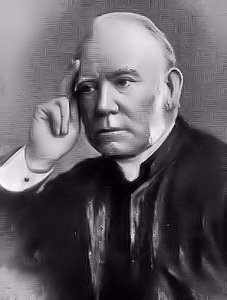Introduction
Baptized: October 31, 1825, Colyton, Devonshire, England.
Died: May 21, 1897.
Buried: Saint Andrews Eastern Cemetery, The Pends, Fife, Scotland.

Baptized: October 31, 1825, Colyton, Devonshire, England.
Died: May 21, 1897.
Buried: Saint Andrews Eastern Cemetery, The Pends, Fife, Scotland.

© 1991 Gareth J. Tuttiett. Used by permission.
The following text was adapted from a talk given by Gareth J. Tuttiett to the Somerset & Dorset Family History Society, at Street Library, Somerset, United Kingdom, in 1991.
William [Tuttiett]’s youngest son, Lawrence (sometimes spelt Laurence, but in the Parish Register, it is definitely Lawrence) was born in Colyton, Devon, and baptised on 31 October 1825.
He, like his two brothers, Frank and Henry, was educated at Christ’s Hospital and at King’s College, London, where he came under the influence of Maurice and Kingsley.
He intended to devote himself to the study medicine but was called to Holy Orders in 1848. By 1849, he had become a priest, and the following year became curate at St. Paul’s, Wilton Place, Knightsbridge, London. Then in 1850, he became curate of St. Thomas’ and later Holy Trinity in Ryde, on the Isle of Wight. He was off again, in 1853 to become curate at Longton, Stoke-on-Trent, Staffordshire.
The Reverend Lawrence was instituted as curate at Lea Marston, Warwickshire, in 1854, and from September 1868 until towards the end of 1869 he was vicar. The annual vestry meetings show that he regularly took the chair.
In 1854, Lawrence married Helen Carnegy, and they lived at Marston parsonage. Helen Hunter, their daughter, was christened on the 14th October, 1855 and Lawrence, as curate, performed the ceremony himself.
He was an active member of the Parent Society, and in 1859, he visited Swansea for the meeting of the National Education Society of Swansea. The Cambrian, of 9th September, 1859, has a paragraph in which Lawrence speaks in support of the resolution to give £550 to the Swansea National Schools.
I quote, “The Rev. L Tuttiett, deputation from the Parent Society, seconded the resolution, and in doing so referred to the necessity which still existed for the establishment of schools in rural and agricultural districts. He also contended that one of the fundamental principles of the National Society was, that the church catechism should be taught in every school where assistance was granted.
This, he maintained, as a member of the established church, was necessary, and could not be abandoned without impairing the efficiency of the whole system of the education now taught in these schools.”
He served as rector at the Scottish Episcopal Church of St. Andrew, Queen’s Gardens, St. Andrews, Fife (1870–93). In 1877 he was nominated as canon of St. Ninian’s Cathedral, Perthshire, which post he held until his death on 21 June 1897 at his residence at 3 Abbotsford Crescent, St. Andrew’s.
According to the Death Roll for Lawrence, which appeared in the Daily Chronicle, 24th May, 1897, “At St. Andrews, which is crowded in the golfing season with English visitors, he attracted to his beautiful church many distinguished men, and was particularly a friend of the late Prince Leopold.
To the students at St. Mary’s College, in the university, he was ever kind, helpful, and considerate, and was wont to delight them with reminiscences of his own laborious days at King’s College, London.
Tuttiett wrote many poems, devotional and theological books, but is better known for his hymns, the most well known being, Father let me dedicate.
John Julian, in his work Dictionary of Hymnology, states, Mr. Tuttiett’s hymns are characterised by smoothness of rhythm, direction of aim, simplicity of language, and deep earnestness. Those for special services and seasons are of great merit.